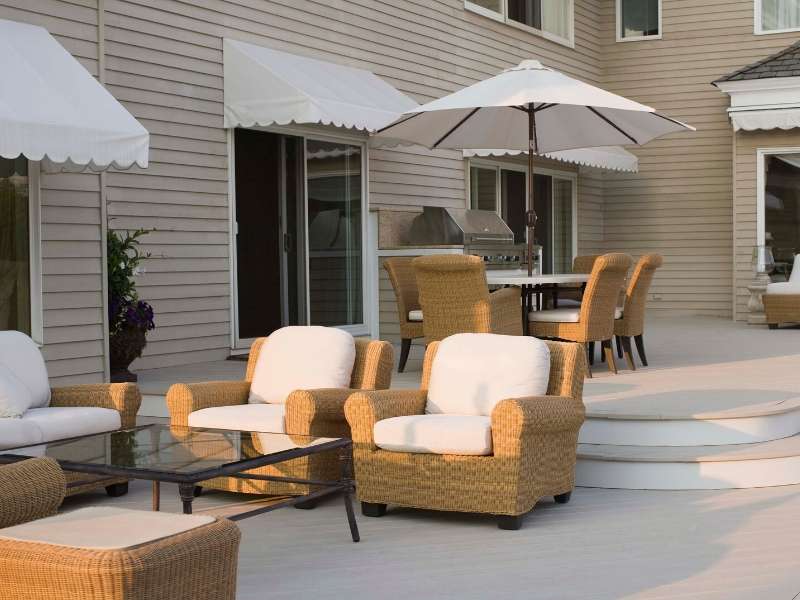Nature is a natural relaxant. That’s why the new trends for home decorations are are full of green home ideas. Adapting green home ideas naturally relieves stress and refreshes our lifestyle. Green homes are also environmentally sustainable while focusing on the efficient use of energy, water, and building materials.
Eco-friendly products are items that don’t harm the environment – whether in their production, use, or disposal. The products you choose for your house can save your money and the environment in the long run when you choose to go for eco-friendly items. Hence, choosing eco-friendly products allows your home to be in harmony with the environment.
If this is something you want to look further into, here are some tips for choosing the best eco-friendly items for your home.
The Best Green Home Ideas & Inspirations

⎆ Use Non-toxic Materials
The chemicals from paint, furniture, and fabrics have adverse effects on human health, such as respiratory problems including asthma and allergies. Most of these chemicals contain volatile organic compounds (VOCs) that are hazardous to the environment. The most common toxic chemicals found in furniture are flame retardants and formaldehyde.
Here are some of the tag labels you need to consider when looking for non-toxic products:
- Greenguard Certified: Greengard certified furniture ensures that it has low toxicity. For instance, products from bedding manufacturers, like the Avocado Mattress, are Greenguard certified. The products are tested for chemicals, such as VOCs, formaldehyde, and phthalates.
Thus, to ensure you’re not buying furniture that contains toxic materials, it’s best to check if it’s Greenguard certified.
- Green Label Plus: When buying carpets, look for a “green label plus” tag because these products don’t release toxic chemical fumes.
- Low VOC: Items with a “low VOC” product label is an indicator of water-based chemicals. These products don’t emit volatile organic compounds.
⎆ Look for Products from Recycled Materials
Be sure to identify which products are from recycled materials. Some products in the market can deceive you with recyclable content labels.
SCS (Scientific Certification Systems) is a global company that certifies items or products with recycled content claims. To ensure you’re buying the genuine one, look for items that with SCS certified green products labels.
You can save money when you buy recyclable products on the market. The best thing with recyclable ones is that you can use them over and over again. Certified Cradle to Cradle (C2C) is one of the best options for recycled furniture.
⎆ Try Out Natural Bamboo Furniture
Bamboo is a sustainable and versatile material. It is in use as flooring and also transforms into modern furniture. Bamboo is safe and it naturally creates a green space in your house.
Yet, using bamboo materials in furniture has disadvantages, too. For instance, some bamboo fixtures have formaldehyde glue hinges. So, it’s wise to look into the source of all of the materials that go into the manufacturing of bamboo fixtures and furniture.
⎆ Buy Certified Sustainable Wood Furniture
Look for wooden furniture from forests with sustainable harvests. You may also consider the beautiful reclaimed wood product. What’s more, reusing the wood increases the efficiency of resources. That’s a “green win” for everyone! However, to ensure that the wood is from a sustainable harvest, look for product certification by Forest Stewardship Council (FSC).
⎆ Thermal Alternatives for Insulation
You can save money on energy by using thermal lining for your house. These materials are a necessity to regulate the heat flow by minimizing the rate of diffusion of cold or warm air to the outdoors.
The use of fiberglass insulation isn’t favorable because it causes many toxic health issues. To make your insulation more sustainable and eco-friendly, consider the following items:
- Sheep’s Wool: This material has compressed wool fibers that form micro-structures of air pockets. The outer surface is resistant to water while the inner surface absorbs moisture. Its unique structure prevents condensation while the heat generates. The process keeps your home warm in the winter and cool in the summer.
- Cotton or Denim: The material is natural and renewable. Also, it’s a natural insect repellent. Unlike fiberglass, it doesn’t contain formaldehyde, which causes respiratory problems.
- Icynene: This is a spray foam from castor oil. Additionally, it is one of the strongest thermal alternatives. When you apply the material, it expands around 100 times its volume, increasing its thickness. Also, due to its insulation, it seals leaks and minimizes noise.
- ThermaCork: This material has a negative carbon footprint. It’s natural and renewable because it’s from the outer bark of the oak tree, specifically, the Quercus suber species of oak tree.
Conclusion
Take note that there are products with “green labels” even though they’re not, which makes it hard for buyers to distinguish genuine eco-friendly items. However, read the tips above and they will go along way in helping you choose the right eco-friendly materials.
If you have any questions or comments, please do so in the comments below. You will also find other interesting links to more excellent information about all things design!
Images Courtesy of Canva.
Door Lock Types: An Essential Homeowners’ Guide
8 Ways to Boost Your Curb Appeal
New Zealand – Nature’s Perfectly Designed Location for Movies





